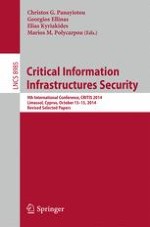2016 | Buch
Critical Information Infrastructures Security
9th International Conference, CRITIS 2014, Limassol, Cyprus, October 13-15, 2014, Revised Selected Papers
herausgegeben von: Christos G. Panayiotou, Georgios Ellinas, Elias Kyriakides, Marios M. Polycarpou
Verlag: Springer International Publishing
Buchreihe : Lecture Notes in Computer Science
